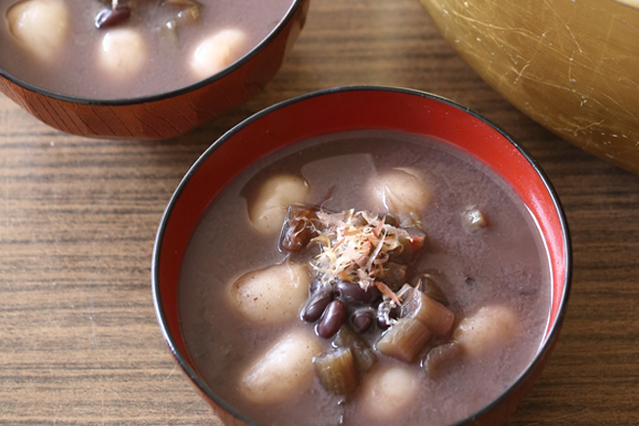Discover Chobo Jiru: A Traditional Delicacy from Hyogo Prefecture, Awaji City
Sep 01,2015
Discover Chobo Jiru: A Traditional Delicacy from Hyogo Prefecture, Awaji City
Sep 01,2015
In this irregular series, food culture researcher Kiyoshi Aya describes the local delicacies and ways of life she has encountered in different places throughout Japan.


Kiyoshi tells us in this article about chobo-jiru, a traditional soup found in the island town of Awaji in Hyogo prefecture. Awaji has a custom in which mothers make chobo-jiru for their daughters after they give birth to a child. The soup’s stock is made from small dried sardines. Dumplings made with rice cake flour, taro stems, and sasagi (a variety of black-eyed peas) are added to the stock, which is flavored with miso and finally topped with dried bonito flakes. It looks like zenzai [sweet red bean soup], but it tastes more like miso soup.
“Taro stems are rich in calcium and, according to tradition, supposedly cleanse the blood by purging old blood. Rice cake and sasagi both have high nutritive value to revitalize the body. The food customs and wisdom handed down over the ages make sense, in my opinion.” As Kiyoshi says, chobo-jiru is a dish mothers definitely want their daughters to eat to recover their strength and vitality after giving birth. Even when a daughter marries and moves off the island, her mother will pack up taro stems, sasagi, rice cake flour, and other ingredients in preparation and exercise her cooking skills at her daughter’s new home. It is customary that not only will the mother feed her daughter, she will make a pot full of chobo-jiru and serve it to friends and relatives who come to celebrate the birth of the child.


“The name chobo-jiru has several origin stories. One theory says that the name comes from the wish that the baby will have ochobo-guchi [pouty lips]. Another claims the name comes from certain areas that put navel-like indentations in the dumplings that are called chobo. Regardless of the source of the name, the shape of the dumplings have significance. When a girl is born, the dumplings are made perfectly round or a small dent is made in the middle. When a boy is born, the dumplings are made with a pointy tip. In this way, people wish for the child to grow up healthy.
“The custom in Nagano and northern Kanto is to feed koikoku [carp stewed in miso soup] and other dishes to a new mother after childbirth, but chobo-jiru is an original dish local to Awaji Island. The soup has spread everywhere on the island, but some areas apparently call it shiru-dango [soup dumplings].”

“Chobo-jiru was formerly a meal for women after childbirth. But fewer and fewer young women today eat chobo-jiru after giving birth. On the other hand, there are more opportunities now for sightseers to the island to get a taste of the soup.”
Women’s groups on the island sell handmade chobo-jiru directly at various events, and some restaurants serve it as a local delicacy. The soup has even been incorporated into school lunches. “Even if chobo-jiru only appears on the menu once a year, kids will still be able to eat it six times during their elementary school years and the memory of it will remain with them.”
“Awaji Island is home to many other delicious dishes besides chobo-jiru. The former Awaji Province, along with the provinces of Wakasa and Shima, was called Miketsu-kuni — lands of royal provisions. Before the Heian period (794 to 1185), it was place where people were required to offer food to the Imperial Court. The island was said to produce salt, abalone, seaweed, and other marine products, as well as so, a condensed dairy product eaten in ancient Japan reminiscent of modern cheese. Consistent with its fertile history, the island has a unique food culture, along with an abundance of ingredients and delicious food products. I hope chobo-jiru, brimming with mothers’ love, will be one of the local delicacies passed on to younger generations.”

food culture researcher
food culture researcher
food culture researcher and Secretary of the Research Division at the National Council for Washoku Culture
Born in Osaka prefecture, Kiyoshi is involved in researching traditional regional Japanese cuisine and the dietary habits in fishing and farming communities as well as writing and giving lectures about local foods.
Recent publications include Washoku Techo [Washoku Handbook] (co-author, published by Shibunkaku), Furusato no Tabemono [Hometown Food] (Washoku Culture Booklet No. 8) (co-author, published by Shibunkaku), and Shoku no Chizu [Maps of Food], Third Edition (published by Teikoku-Shoin).